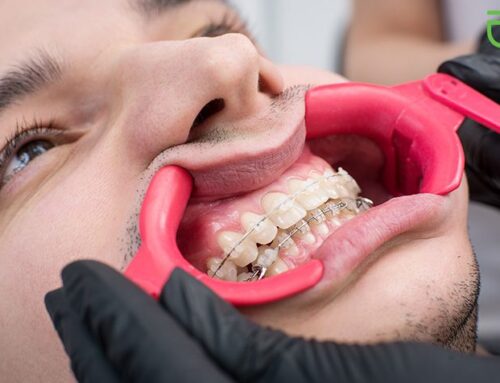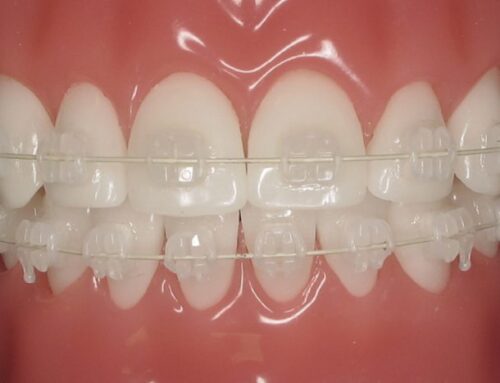Understanding the Advantages of Ceramic Braces
If you’re considering having orthodontic treatment to straighten your teeth and beautify your smile but are a bit apprehensive about the look and style of traditional metal braces, you’re not alone. Many patients are not necessarily keen on the potential of having metal brackets, wires, and bands as a part of their smile, even for a short period of time.
If this sounds like you, then we would like to tell you about other options that are available to help you get the smile you’ve always wanted, such as ceramic braces.
In this article, we’ll explain what ceramic braces are and how they work. There are several differences that set them apart from traditional metal braces, and they also have many advantages to offer. While the actual treatment process is virtually identical to that of metal braces, there are a few things that need to be considered for patients with ceramic braces in order to get the best results, which we will explain throughout this article. Now, let’s start things off by taking a closer look at ceramic braces and how they work.
How Ceramic Braces Work & How Are They Different
First and foremost, it’s important to know the different components of a set of braces, and the function that each one performs. In general, braces consist of the following parts:
- brackets, bands
- wires
This list of base components is pretty much the same between traditional metal braces and ceramic braces, but the materials used in their manufacture are different. Let’s look at each of these parts in detail:
Brackets – These are small fixtures that are adhered to each individual tooth. Brackets are designed to provide a secure and stable connection between the other components of the braces and the teeth in the patients’ mouth. This is where the biggest difference between metal and ceramic braces come from. For ceramic braces, the brackets are manufactured using a composite ceramic material. This composite material can be made in a variety of shades in order to precisely match your natural tooth colour, making them nearly invisible on your teeth.
Bands – Usually used on molars, thin, flat metal bands are wrapped around the outside of the tooth and include a bracket attached to the outside. They perform essentially the same function as brackets but provide additional stability and security around larger teeth. If a band is needed as part of your orthodontic treatment, they will be standard metal bands even with ceramic braces. Fortunately, since these bands are usually placed only at the back of your mouth, they are generally not visible.
Wires – Also known as ‘archwires’, these are thin metal wires that run through each band and bracket of the braces around the perimeter of your mouth. The wires are shaped specifically to provide tension and pressure in a precise pattern across your teeth in order to encourage the teeth to move along a specific path and in to the proper position. Although archwires are typically silver metal, they can also be made with a white or frosted coating to make them much less noticeable, especially when combined with ceramic brackets.
Ligatures – These are the small rubber rings that are used to wrap around the brackets and overtop of the wire in order to securely hold everything together. The ligatures ensure that the wires remain in place and can be removed and replaced by your orthodontist at each incremental adjustment when a new wire is applied. Ligatures are available in every colour of the rainbow, and many patients use them as a method of applying some personalization or fun to their braces by choosing their favourite colour or getting creative with patterns. For patients who want to keep their orthodontic treatment subtle and low-profile, you can choose from clear, white, or tooth-shaded ligatures.
In summary, ceramic braces function much the same as traditional metal braces, but use brackets, wires, and ligatures that are designed to more closely match the colour of your natural teeth and make them less noticeable as you go about your usual routines and your day-to-day life.
Advantages of Ceramic Braces
The advantages of ceramic braces are clear to see, even though the braces themselves may be hard to spot at first glance! Their discreet appearance appeals to many patients who would otherwise feel self-conscious about orthodontic appliances on their teeth. In addition, since the process of undergoing treatment is virtually identical with ceramic or metal braces, you can be sure that you won’t be sacrificing results by choosing an alternative style instead of metal braces. At the end of your treatment, once your braces have been removed, you’ll be delighted with the look of your smile and how easy it was to get it.
How to Get Started with Ceramic Braces
If you feel that ceramic braces may be the solution you’ve been waiting for, the process starts with a consultation. During this consultation, your orthodontist will ask you an in-depth series of questions and review your dental health history before making their recommendations on what the best treatment methods for you will be. It’s important to have a clear idea of what your goals and objectives for your orthodontic treatment are and communicate these with your orthodontist during your consultation. It’s possible that there may be an alternative method of treatment that could offer you better or faster results, so be sure to consider all your options before committing.
Ceramic Braces Costs
During this free, no-obligation consultation, you will also discuss costs, however expect a range between $4,000-$8,000 depending on the specifics of your case.
Steps in Ceramic Braces Treatment
After your consultation is complete, and if your orthodontist believes that ceramic braces are the best treatment option for you, your next appointment will be scheduled, and you’ll start your course of treatment. First, detailed scans and x-rays will be taken of your mouth so that your orthodontist can plan out the necessary movement of your teeth to the final desired position. These scans and x-rays will also be used to help craft your set of braces to precisely fit your teeth and mouth for maximum comfort. Once the complete set of braces are ready, you will have an appointment with your orthodontist to have them applied to your teeth and the first adjustment increment will begin.
You will then have regular visits with your orthodontist to monitor progress and have adjustments made. Each of these adjustments will move the teeth a set distance in your mouth along the path to their final placement. You will be given a new set of wires and ligatures at each adjustment appointment.
Once the course of your treatment has concluded, your braces will be removed by your orthodontist and you will likely have a few follow-up appointments to make sure everything is staying put. Most patients are also provided with a custom-fitted retainer for wearing at night or a mouthguard to be worn during sports activities in order to give added assurance that your teeth remain in the correct position long after the braces are removed.
Conclusion
Choosing to get braces is a wise decision for many patients. It’s a simple method to achieving a beautiful, straight set of teeth and the smile you’ve always wanted. If you’ve been considering braces, or your dentist or orthodontist are recommending them for you, you should ask them whether ceramic braces would be a good option for you. As you can see, they have many benefits over traditional styles. So, if the idea of shiny metal braces doesn’t appeal to you, then consider looking in to ceramic braces. They may be just the thing you need to help get your smile back in style.
If you’d like to start the process with a free, no-obligation ceramic braces consultation, contact us today and we’d be glad to help answer any questions you may have.
Our experienced team of dental and orthodontic professionals will help guide you through every step of your treatment and make sure you get the best results.
Appointment Request
If you’re interested in any of our procedures, and would like to meet with one of our dentists to discuss options, costs and get additional information, complete this short form and we’ll give you a call to arrange for a no-obligation appointment at our Barrie clinic.










